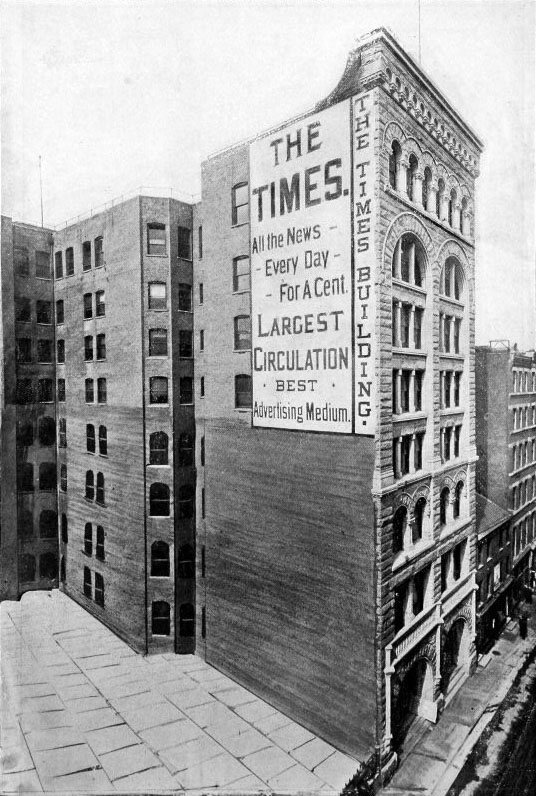The Pittsburg Times on:
[Wikipedia]
[Google]
[Amazon]
''The Pittsburg Times'' was a morning daily newspaper published in


 The ''Times'' began publication on 2 February 1880, with '' Pittsburgh Leader'' veteran Robert P. Nevin as founder, proprietor and editor. It was issued every morning except Sunday and was Republican in politics.
In 1884, Nevin sold out to a company headed by local political boss Christopher Magee. The new publishers attracted subscribers by cutting the price of an issue from two cents to a penny, and by the end of the decade, reported a daily circulation exceeding that of the city's other morning papers.
Having outgrown a series of modest quarters, the ''Times'' moved in 1892 to its new eight-story Times Building, designed by Frederick J. Osterling in
The ''Times'' began publication on 2 February 1880, with '' Pittsburgh Leader'' veteran Robert P. Nevin as founder, proprietor and editor. It was issued every morning except Sunday and was Republican in politics.
In 1884, Nevin sold out to a company headed by local political boss Christopher Magee. The new publishers attracted subscribers by cutting the price of an issue from two cents to a penny, and by the end of the decade, reported a daily circulation exceeding that of the city's other morning papers.
Having outgrown a series of modest quarters, the ''Times'' moved in 1892 to its new eight-story Times Building, designed by Frederick J. Osterling in
Pittsburgh
Pittsburgh ( ) is a city in the Commonwealth (U.S. state), Commonwealth of Pennsylvania, United States, and the county seat of Allegheny County, Pennsylvania, Allegheny County. It is the most populous city in both Allegheny County and Wester ...
, Pennsylvania
Pennsylvania (; (Pennsylvania Dutch: )), officially the Commonwealth of Pennsylvania, is a state spanning the Mid-Atlantic, Northeastern, Appalachian, and Great Lakes regions of the United States. It borders Delaware to its southeast, Ma ...
, from 1880 to 1906. It was a predecessor of ''The Gazette Times
The ''Pittsburgh Post-Gazette'', also known simply as the PG, is the largest newspaper serving metropolitan Pittsburgh, Pennsylvania. Descended from the ''Pittsburgh Gazette'', established in 1786 as the first newspaper published west of the Alle ...
'', which in turn was succeeded by the present-day ''Pittsburgh Post-Gazette
The ''Pittsburgh Post-Gazette'', also known simply as the PG, is the largest newspaper serving metropolitan Pittsburgh, Pennsylvania. Descended from the ''Pittsburgh Gazette'', established in 1786 as the first newspaper published west of the All ...
''.
History


 The ''Times'' began publication on 2 February 1880, with '' Pittsburgh Leader'' veteran Robert P. Nevin as founder, proprietor and editor. It was issued every morning except Sunday and was Republican in politics.
In 1884, Nevin sold out to a company headed by local political boss Christopher Magee. The new publishers attracted subscribers by cutting the price of an issue from two cents to a penny, and by the end of the decade, reported a daily circulation exceeding that of the city's other morning papers.
Having outgrown a series of modest quarters, the ''Times'' moved in 1892 to its new eight-story Times Building, designed by Frederick J. Osterling in
The ''Times'' began publication on 2 February 1880, with '' Pittsburgh Leader'' veteran Robert P. Nevin as founder, proprietor and editor. It was issued every morning except Sunday and was Republican in politics.
In 1884, Nevin sold out to a company headed by local political boss Christopher Magee. The new publishers attracted subscribers by cutting the price of an issue from two cents to a penny, and by the end of the decade, reported a daily circulation exceeding that of the city's other morning papers.
Having outgrown a series of modest quarters, the ''Times'' moved in 1892 to its new eight-story Times Building, designed by Frederick J. Osterling in Richardsonian Romanesque
Richardsonian Romanesque is a style of Romanesque Revival architecture named after the American architect Henry Hobson Richardson (1838–1886). The revival style incorporates 11th and 12th century southern French, Spanish, and Italian Romanesq ...
style. The structure still stands in downtown Pittsburgh's Fourth Avenue Historic District.
''The Pittsburg Daily News'' was launched in 1896 as the sister newspaper and evening counterpart of the morning ''Times''. Half a decade later it was bought and absorbed by the city's leading evening paper, ''The Pittsburg Press
''The Pittsburgh Press'' (formerly ''The Pittsburg Press'' and originally ''The Evening Penny Press'') was a major afternoon daily newspaper published in Pittsburgh, Pennsylvania, from 1884 to 1992. At one time, the ''Press'' was the second larg ...
''.
In 1906, five years after Magee's death, George T. Oliver bought the ''Times'' and merged it with the morning paper he already owned, '' The Pittsburgh Gazette'', to form ''The Gazette Times''. The merged publications were compatible in their conservatism, restraint from sensationalism, and Republican political bent. Prior to consolidation, both papers had a similar daily circulation of about 70,000.
Anti-Masonic paper
An earlier, unrelated ''Pittsburgh Times'' existed roughly contemporaneously with the national Anti-Masonic movement of the late 1820s and the 1830s. Founded in 1829 as the (''Anti-Masonic'') ''Examiner'', it became the ''Times'' in January 1831. The paper was established in opposition toFreemasonry
Freemasonry or Masonry refers to fraternal organisations that trace their origins to the local guilds of stonemasons that, from the end of the 13th century, regulated the qualifications of stonemasons and their interaction with authorities ...
and for most of its existence catered to "those who prefer the Supremacy of the Laws to the domination of the Lodge." It was issued on a weekly basis, with a short-lived daily edition in 1837. It discontinued publication on , transferring its subscription list and accounts to the ''Gazette''.
Notes
References
{{DEFAULTSORT:Pittsburg Times, The Newspapers established in 1880 Publications disestablished in 1906 Defunct newspapers published in Pittsburgh Defunct daily newspapers 1880 establishments in Pennsylvania 1906 disestablishments in Pennsylvania